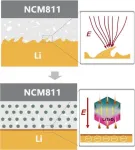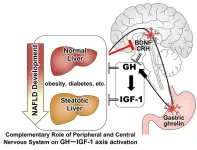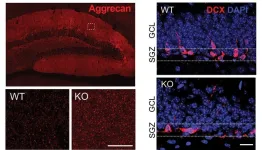(Press-News.org) Lithium-ion batteries powered the device on which these words appear. From phones and laptops to electric vehicles, lithium-ion batteries are critical to the technology of the modern world — but they can also explode. Comprising negatively and positively charged electrodes and an electrolyte to transport ions across the divide, lithium-ion batteries are only as good as the limitations of their components. Liquid electrolytes are potentially volatile at high temperatures, and their efficiency can be limited by nonuniformity and instabilities in the other components.
Researchers are working toward developing safer, more efficient batteries with solid electrolytes, a significant change over the liquid version that currently transports ions in most commercially available batteries now. The challenge is that each solid-state material has as many drawbacks as advantages, according to a team based at the Shenzhen All-Solid-State Lithium Battery Electrolyte Engineering Research Center in Tsinghua Shenzhen International Graduate School’s Institute of Materials Research.
To solve this conundrum, the researchers combined two of the prime solid-state candidates — ceramic and polymer — into a new composite electrolyte.
They published their results on Sept. 21 in Energy Materials and Devices.
“Composite solid-state electrolytes have received significant attention due to their combined advantages as inorganic and polymer electrolytes,” said co-first author Yu Yuan, who is also affiliated with Tsinghua Shenzhen International Graduate School. “However, conventional inorganic ceramic fillers offer limited ion conductivity enhancement for composite solid-state electrolytes due to the space-charge layer between the polymer matrix and ceramic phase.”
Inorganic ceramic electrolytes offer high conductivity, but they develop resistance when faced with another solid and are complicated to synthesize. Polymer electrolytes are easier to produce, more flexible and work better with electrodes, but their conductivity at room temperature is too low for commercial application. According to Yuan, combining the two should produce a highly conductive, flexible electrolyte that is easier to synthesize. In reality, however, when mixed, the composite solid-state electrolytes have a separation — called a space-charge layer — between their constituent parts that limits their conductivity.
To correct this, the researchers used lithium tantalate, which has a crystalline structure that lends itself to unique optical and electrical properties, as a functional filler to mitigate the space-charge layer. The ceramic ion conductor material is ferroelectric, mean it can reverse electric charge when a current is applied.
“Not only does the filler alleviate the space-charge layer, but it also provides an extra lithium-ion transport pathway,” said co-first author Likun Chen, who is also affiliated with Tsinghua Shenzhen International Graduate School.
The researchers experimentally demonstrated that the lithium tantalate filler eases the bottleneck for lithium-ion transport across the polymer-ceramic interface, resulting in lithium ions moving in both increased numbers and speed through the electrolyte.
The result, the researchers said, is an electrolyte with high conductivity and a long-cycling life — referring to how often the ions can be transported across the battery in charging and discharging cycles — even at low temperatures.
“This work proposes a novel strategy for designing integrated ceramic fillers with ferroelectric and ion-conductive properties to achieve high-throughput lithium-ion transport of composite-solid electrolytes for advances solid-state lithium metal batteries,” Yuan said. “Our approach sheds light on the design of functional ceramic fillers for composite solid-state electrolytes to effectively enhance ion conductivity and battery performance.”
Other co-authors include Yuhang Li, Xufei An, Jianshuai Lv, Shaoke Guo, Xing Cheng, Yang Zhao, Ming Liu, Yan-Bing He and Feiyu Kang. Li, An, Lv, Guo, Cheng, Zhao and Kang are also affiliated with Tsinghua Shenzhen International Graduate School.
The National Natural Science Foundation of China, Key-Area Research and Development Program of Guangdong Province, Shenzhen Outstanding Talents Training Fund, All-Solid-State Lithium Battery Electrolyte Engineering Research Center and Shenzheng Technical Plan Project supported this research.
##
About Energy Materials and Devices
Energy Materials and Devices is launched by Tsinghua University, published quarterly by Tsinghua University Press, aiming at being an international, single-blind peer-reviewed, open-access and interdisciplinary journal in the cutting-edge field of energy materials and devices. It focuses on the innovation research of the whole chain of basic research, technological innovation, achievement transformation and industrialization in the field of energy materials and devices, and publishes original, leading and forward-looking research results, including but not limited to the materials design, synthesis, integration, assembly and characterization of devices for energy storage and conversion etc.
About SciOpen
SciOpen is a professional open access resource for discovery of scientific and technical content published by the Tsinghua University Press and its publishing partners, providing the scholarly publishing community with innovative technology and market-leading capabilities. SciOpen provides end-to-end services across manuscript submission, peer review, content hosting, analytics, and identity management and expert advice to ensure each journal’s development by offering a range of options across all functions as Journal Layout, Production Services, Editorial Services, Marketing and Promotions, Online Functionality, etc. By digitalizing the publishing process, SciOpen widens the reach, deepens the impact, and accelerates the exchange of ideas.
END
November 3, 2023 -- The American Federation for Aging Research (AFAR), a national non-profit whose mission is to support and advance healthy aging through biomedical research, will host its annual Scientific Awards of Distinction lectures and ceremony on Friday, November 10 from 6:30pm-9:00pm ET in conjunction with the Annual Scientific Meeting of the Gerontological Society of America (GSA) held in Tampa, Florida. In addition to an awards presentation and reception, the honorees will present lectures highlighting their research.
Rafael de Cabo, PhD, will receive the 2023 Irving S. Wright ...
MELVILLE, N.Y., November 3, 2023 – An examination of the impact of image size on measurements from magnetic force microscopy has won the Advances in Magnetism Award, sponsored by AIP Advances, published by AIP Publishing.
The paper, “Finite image size effects on the characterization of magnetic domain patterns via magnetic force microscopy,” was selected as the winner from nearly 200 papers submitted as part of the 2022 Magnetism and Magnetic Materials conference. Michael Vaka, now a data engineer at Zontal, was awarded a cash prize and a travel stipend to next year’s ...
The annual meeting for the American Physical Society’s (APS) Division of Fluid Dynamics will begin in two weeks with presentations on new research in aerodynamics, turbulence, wind and water power, bubbles, culinary fluid dynamics, medicine, and more. The conference will be held in person at the Walter E. Washington Convention Center in Washington, DC, Nov. 19-21.
There are no press conferences planned for this year’s program. However, a tip sheet highlighting newsworthy presentations is now available in the meeting’s press kit. Registered journalists ...
The sky is no longer the limit — but taking flight is dangerous. In leaving the Earth’s surface, we lose many of the cues we need to orient ourselves, and that spatial disorientation can be deadly. Astronauts normally need intensive training to protect against it. But scientists have now found that wearable devices which vibrate to give orientation cues may boost the efficacy of this training significantly, making spaceflight slightly safer.
“Long duration spaceflight will cause many physiological and psychological stressors which will make astronauts very susceptible to spatial disorientation,” ...
Niigata, Japan – The research group of Professor Kamimura in Niigata University have demonstrated the complementary role of peripheral and central nervous system on GH–IGF-1axis activation to prevent MASLD progression. IGF-1 ameliorates fatty infiltration in the liver. Its release is controlled by GH and GH activation is managed by peripheral or central nervous system. However, the role of this axis in MASLD developmental phase has not been well identified. Our study demonstrated that the GH–IGF-1 axis is significant in inhibiting the progression of MASLD. In addition to the peripheral autonomic ...
Researchers have reached an agreement on how best to measure the severity and impact of Long COVID by identifying a “Core Outcome Measure Set” (COMS).
The research, published in Lancet Respiratory Medicine is co-led by the Institute of Psychiatry, Psychology & Neuroscience (IoPPN) at King’s College London and in collaboration with the World Health Organisation (WHO).
COMS are designed to help researchers and clinicians measure symptoms and impacts of disorders such as Long COVID in the same way, which optimises how data can be compared and summarised. Researchers say this will accelerate the understanding of, and the development ...
A new Cochrane review has found that insulin can be kept at room temperature for months without losing potency, offering hope to people living with diabetes in regions with limited access to healthcare or stable powered refrigeration. This affects millions of people living in low- and middle-income countries, particularly in rural areas, as well as people whose lives have been disrupted by conflict or natural disasters.
Human insulin is a hormone produced by the body that helps turn food into energy and controls blood sugar levels. People with diabetes cannot make enough insulin and those with type 1 diabetes have to inject insulin several times a day, typically before every meal. ...
EMBARGOED: Not for Release Until 00:01 AM (UK Time) on Friday 3 November 2023
New research highlights the need for routine discussions about eye donation in end-of-life care clinical settings
Less than four per cent of eligible patients in end-of-life care settings were asked to consider eye donation
Patients had positive views about eye donation, but most did not know it could be an option for them
Staff need training and guidance to support discussing eye donation with patients
A new study has found there is significant scope to increase the number of eye donations from patients cared for in hospice and palliative care settings - donations which are desperately needed for ...
PHILADELPHIA— Phenylketonuria (PKU) is a rare newborn genetic disease that impacts between 1 in 10,000 to 1 in 20,000 people, depending on the individuals’ genetic ancestry. PKU causes an amino acid—called phenylalanine (Phe)—to build up in the bloodstream. Uncontrolled PKU can lead to intellectual disability, psychiatric issues, and seizures. While current therapies can partially improve outcomes, they require meticulous, lifelong compliance that is very difficult for most patients. ...
Mount Sinai researchers have shed valuable light on the mechanism of a key protein that regulates the plasticity and function of the hippocampus, a key brain region involved in memory and learning, and that decreases with age in mice.
The team’s findings, published in Molecular Psychiatry, could pave the way for a better understanding of how the protein, known as tissue inhibitor of metalloproteinases 2 (TIMP2), could potentially be targeted in age-related disorders like Alzheimer’s disease to help restore ...




